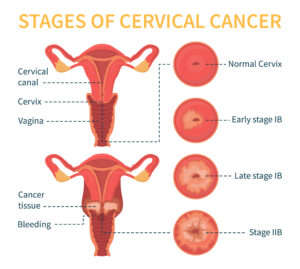Introduction
Cervical Cancer, primarily caused by the Human Papillomavirus (HPV), poses a significant threat to women’s health globally. Despite being highly preventable, it remains a leading cause of Cancer-related deaths, particularly in developing countries.
This article delves into the multifaceted aspects of Cervical Cancer, exploring its causes, symptoms, diagnosis, and treatment options in depth to provide a comprehensive understanding of this disease.
What is Cervical Cancer?
Cervical Cancer is a type of Cancer that develops in the cells of the cervix, the lower part of the uterus that connects to the vagina. It is typically caused by the human papillomavirus (HPV), a sexually transmitted infection.
Cervical Cancer can often be prevented through HPV vaccination and regular screenings such as Pap tests. Symptoms may include abnormal vaginal bleeding, pelvic pain, or pain during intercourse. Early detection and treatment can greatly improve outcomes for those diagnosed with Cervical Cancer.
Types of Cervical Cancer

Cervical Cancer is primarily categorized into two main types:
Squamous cell carcinoma:
This type accounts for the majority of Cervical Cancers, arising from the thin, flat cells lining the outer surface of the cervix.
Adenocarcinoma:
Less common than squamous cell carcinoma, adenocarcinoma develops from the glandular cells lining the cervical canal.
In addition to these two main types, there are other rare types of Cervical Cancer, such as adenosquamous carcinoma and small cell carcinoma, but they account for a small percentage of cases. Understanding the specific type of Cervical Cancer is crucial for determining the most effective treatment approach.
What Causes Cervical Cancer?
The primary cause of Cervical Cancer is infection with certain types of the human papillomavirus (HPV), a common sexually transmitted infection. HPV infection is extremely common, but in most cases, the immune system clears the virus without causing any symptoms or health problems. However, in some cases, certain high-risk strains of HPV can persist, leading to changes in the cells of the cervix that can eventually progress to Cervical Cancer.
Other factors that can increase the risk of developing Cervical Cancer include:
- Smoking: Tobacco use can weaken the immune system, making it less able to fight HPV infections and increasing the risk of Cervical Cancer.
- Weak immune system: Individuals with weakened immune systems, such as those with HIV/AIDS or those who have undergone organ transplants and are taking immunosuppressive medications, are at a higher risk of developing Cervical Cancer.
- Early sexual activity: Engaging in sexual activity at an early age increases the risk of HPV infection, which can lead to Cervical Cancer.
- Multiple sexual partners: Having multiple sexual partners increases the risk of exposure to HPV and other sexually transmitted infections, increasing the risk of Cervical Cancer.
- Poor socioeconomic status: Limited access to healthcare and preventive services such as Pap tests and HPV vaccination can increase the risk of developing Cervical Cancer.
Cervical Cancer Symptoms
Cervical Cancer often progresses silently in its early stages, manifesting minimal or no symptoms. However, as the disease advances, symptoms may become noticeable, including:
- Abnormal vaginal bleeding: This may occur after sexual intercourse, between menstrual periods, or after menopause.
- Unusual vaginal discharge: Changes in vaginal discharge, such as color, consistency, or odor, may indicate cervical abnormalities.
- Pain during intercourse: Discomfort or pain during sexual intercourse can be a symptom of Cervical Cancer.
- Pelvic pain: Persistent or intermittent pelvic pain may indicate advanced stages of Cervical Cancer.
How Is Cervical Cancer Diagnosed?
Cervical Cancer is diagnosed through a combination of screening tests and diagnostic procedures. The main methods used for diagnosing Cervical Cancer include:
- Pap test (Pap smear): During a Pap test, cells from the cervix are collected and examined under a microscope for any abnormalities. Pap tests can detect preCancerous changes in the cells of the cervix, allowing for early intervention before Cancer develops.
- HPV test: This test detects the presence of high-risk strains of the human papillomavirus (HPV) in cells collected from the cervix. HPV testing is often performed in conjunction with a Pap test, especially for women over 30, as HPV infection is the primary cause of Cervical Cancer.
- Colposcopy: If abnormal cells are detected during a Pap test or HPV test, a colposcopy may be performed. During this procedure, a special magnifying instrument called a colposcopy is used to examine the cervix more closely. If abnormal areas are identified, a biopsy may be taken for further evaluation.
- Biopsy: A biopsy involves the removal of a small sample of tissue from the cervix for examination under a microscope. This procedure allows for the definitive diagnosis of Cervical Cancer and provides information about the type and stage of the Cancer.
- Imaging tests: In some cases, imaging tests such as ultrasound, CT scan, or MRI may be performed to determine the extent of the Cancer and whether it has spread to other parts of the body.
Treatment Options for Cervical Cancer
The Treatment for Cervical Cancer depends on several factors, including the stage of the cancer, the type of Cervical Cancer, the patient’s overall health, and their personal preferences. Treatment options may include:
Surgery:
Surgery may be used to remove the cancerous tissue from the cervix. The type of surgery performed depends on the stage and location of the cancer. Surgical options may include:
- Conization (LEEP): Removal of a cone-shaped piece of tissue from the cervix.
- Simple hysterectomy: Removal of the uterus and cervix.
- Radical hysterectomy: Removal of the uterus, cervix, and surrounding tissues, such as the upper part of the vagina and nearby lymph nodes.
Radiation therapy:
Radiation therapy uses high-energy beams to kill cancer cells. It may be used alone or in combination with surgery or chemotherapy. Radiation therapy for Cervical Cancer may be delivered externally (external beam radiation) or internally (brachytherapy), where radioactive sources are placed directly into or near the tumour.
Chemotherapy:
Chemotherapy uses drugs to kill cancer cells or stop them from growing. Chemotherapy may be used alone or in combination with other treatments, such as surgery or radiation therapy. It is often used for advanced or recurrent Cervical Cancer.
Targeted therapy:
Targeted therapy drugs target specific molecules or pathways involved in the growth and spread of cancer cells. These drugs may be used in combination with chemotherapy for advanced Cervical Cancer.
Immunotherapy:
Immunotherapy drugs help the immune system recognize and attack cancer cells. Some immunotherapy drugs have been approved for the treatment of advanced Cervical Cancer.
Clinical trials:
Clinical trials may offer access to experimental treatments or new combinations of existing treatments for Cervical Cancer. Participation in clinical trials can help advance knowledge about the best ways to treat Cervical Cancer.
The choice of treatment depends on factors such as the stage of the cancer, the patient’s overall health, and their preferences. Treatment plans are often individualized based on these factors, and patients may receive a combination of treatments to achieve the best possible outcome.
Conclusion and Future Perspectives
The fight against Cervical Cancer is ongoing, with significant progress being made in prevention, early detection, and treatment. However, access to quality healthcare remains a challenge, especially for patients in developing countries. Initiatives such as DocTrePat’s collaboration with leading Cancer treatment centres in India play a crucial role in providing accessible and advanced care to patients worldwide.
By offering comprehensive services that encompass all aspects of the medical journey, including consultation, treatment, and support, such partnerships contribute to improving the accessibility and quality of Cervical Cancer care on a global scale.
As research continues and technology evolves, the outlook for Cervical Cancer patients is increasingly optimistic, offering hope for a future where this disease can be effectively managed and prevented.
If you want to know more and need any kind of assistance, kindly Contact DocTrePat.

